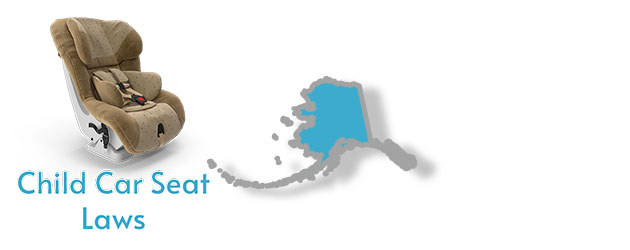A Summary of Child Car Seat Laws in Alaska
What are the Height and Weight Requirements for Car Seats in Alaska?

If a child weighs UNDER 20 pounds, they are required to use a rear-facing car seat.
A weight of over 20 pounds AND an age of between 1 and 4 is required for a child to use a forward-facing car seat.
Children with a weight of 20 pounds or more AND less than 60 pounds with an age of 4 or more can use a booster seat.
The front seat can be used by a child if he or she weighs OVER 65 pounds AND is OVER 4 years old.
What are the Rear-facing Car Seat Laws in Alaska?

In Alaska, children weighing less than 20 pounds and older than one year, or under the age of 1 year are required by law to use a rear-facing child safety seat. This means weight is the most important factor since they cannot stop using this type of seat even if they are older than 1 year. The seat used should meet or exceed the standards set by the United States Department of Transportation. These seats are considered safe because they are designed with features to help protect an infant’s neck and spinal cord from injury in case of an accident. Also, it may help to note that the American Academy of Pediatrics recommends that parents continue to use these seats until their child is at least 2 years old.
What are the Forward Facing Car Seat Laws in Alaska?

Children between the ages of 1 to 4 and with a weight of over 20 pounds have to be secured with a child restraint device (forward-facing seat). The harness should be a 5 point and the child should use the seat until he or she exceeds the manufacturer’s height and weight limits. The device used should also adhere to the United States Department of Transportation standards.
What are the Booster Seat Laws in Alaska?

For children to graduate to a booster seat in Alaska, they have to be over 4 years old but less than 8 years old and have a height of less than 4’9’’. In terms of weight, they have to be 20 pounds or more and weigh less than 65 pounds. The booster seat should be secured by a proper seat belt system or any other system (such as a latch system) that meets the United States Department of Transportation standards. The installed booster seat should help the child to firmly position the regular seat belt over the stronger parts of the body (chest, shoulders and lap).
What are the Requirements for Children to Use the Front Seat in Alaska?

A child can graduate from a booster seat to a regular seat when they are older than 4 years and weigh over 65 pounds or taller than 4’9’’. This means they can stop using the booster seat as long as they have exceeded the age and either weight or height requirements. Also, children between the ages of 8-16 who weigh less than 65 pounds or have a height of less than 4’9’’ can wear a regular seat belt or use a booster seat depending on what the driver deems to be appropriate. So while the state of Alaska does not state a specific age for sitting in the front seat, a child can do so if they have exceeded the booster seat requirements or if they are older than 8 years and a driver has determined that the seat belt firmly fits (safe fit means the seat belt lies firmly across the upper thighs).
Is it Illegal to Leave a Child Inside a Vehicle in Alaska?
It is not against the law to leave a child inside a car in Alaska, although it is not recommended.
Are Car Seats Required in Taxis in Alaska?

Alaska requires all children under 8 years old and under 57″ in height to utilize the appropriate child safety seat. They do not have an exemption for taxis. If you are travelling in a taxi, Uber, Lyft, or other rideshare vehicle in Alaska you will need to ensure that you have the appropriate child safety restraint.
More Alaskan Laws
